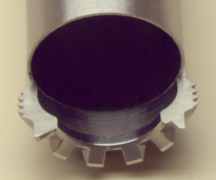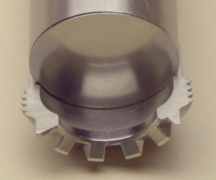

The left coupling is shown without a disc. The right coupling is shown with a disc.
These images of a cutaway coupling shows how a disc blocks the end of the tube to keep moisture out.
Water can enter a bicycle frame from many points. Some of the more common points where water can seep in are around the seat post, headset, handle stem, and water bottle bosses. Many builders provide drain holes at the bottom of the fork tubes, in the seat stays near the rear dropouts and at the bottom bracket to allow accumulated water to drain out. Another way water can get inside is through condensation. Even if you don't ride in the rain, moisture laden air finds it's way into a frame. Then, temperature changes can cause that small amount of moisture to condense on the inside the tubes. As the process repeats itself, a corrosion or rust problem can gradually develop. When a bicycle has couplings, that's another potential point of entry.
To prevent moisture from getting past the couplings and into the inside of your frame tubes, we provide builders with very thin stainless steel discs that can be inserted in the coupling before the coupling is brazed onto the tube. Once the coupling is brazed in place, a seal is created between the end of the tube and the disc. The disc then prevents any water that might enter through the couplings from reaching the inside of the frame tubes. Moisture contained in the stainless steel coupling won't damage it in any way.


The left coupling is shown without a disc. The right
coupling is shown with a disc.
These images of a cutaway coupling shows how a disc blocks the end of the tube to keep moisture
out.
Some builders prefer to not use the discs. Since water will enter at other places in addition to the couplings, their theory is that it's better to leave the coupling open so water that enters the frame at other places above the coupling, can drain down through the coupling to the bottom of the frame where it can escape.
Some cyclists don't want the discs because it blocks the area inside the tube which can be used to store seldom used items and emergency parts such as spokes. Not having discs also makes inspecting the inside of the main frame tubes possible so you know if there is a moisture problem or not. If the discs aren't used, a cork or rubber stopper can be used to block the hole.
On a frame made with or without discs, we recommend coating the inside of the frame with J.P. Weigle Frame Saver. It comes in an aerosol can and can easily be applied through the hole in the center of the coupling.
| Out of Sight, Out of Mind - Rust Never Sleeps by Peter Weigle
True, bicycles have been around for 100 years and there are plenty of
early examples of frames that have lasted lifetimes without rust, so why
all the fuss now? Because in the last couple of decades there have been
major changes in materials, equipment, and bike usage that have made
internal frame protection even more important. |
Another option that some people like is to completely seal off the entire coupling from the outside. Making a sleeve that can be stretched over the couplings from an old inner tube or condom works great for that purpose especially if the bike is being ridded off road in the mud or in the rain. To keep mud off the couplings, Lizard Skins will also work. The are made of very thin wet suit type fabric backed foam material with hook and loop on both sides for easy removal. Lizard Skins are available in bike shops.
If your bike wasn't built with the stainless steel discs, it is possible to use silicone seal to hold a small plastic disc or plug in the end of the coupling which should prevent moisture from getting into the frame yet it can still be removed if it becomes necessary to inspect the inside of the frame. Even a cork or rubber stopper inserted into the hole in the end of the coupling would work as long as it doesn't stick out to interfere with the coupling teeth.
Framebuilder list | Cases | Packing | Photos | Reviews | Comments | Retailer list | Installation | Specifications | Cost | Retrofit or new? | Travel adventures